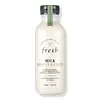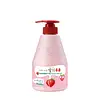What's inside
What's inside
 Key Ingredients
Key Ingredients

 Benefits
Benefits

 Concerns
Concerns

 Ingredients Side-by-side
Ingredients Side-by-side

Water
Skin ConditioningDisodium Cocoyl Glutamate
CleansingCoco-Betaine
CleansingGlycerin
HumectantSodium Cocoyl Isethionate
CleansingCitric Acid
BufferingDecyl Glucoside
CleansingSodium Citrate
BufferingCetearyl Alcohol
EmollientButyrospermum Parkii Butter
Skin ConditioningOlea Europaea Fruit Oil
MaskingCentella Asiatica Extract
CleansingLinum Usitatissimum Seed Extract
PerfumingLinum Usitatissimum Seed Oil
PerfumingHydrolyzed Rice Bran Protein
Skin ConditioningTocopherol
AntioxidantParfum
MaskingSodium Chloride
MaskingXanthan Gum
EmulsifyingCarrageenan
Caprylyl Glycol
EmollientCoconut Acid
CleansingGuar Hydroxypropyltrimonium Chloride
Skin ConditioningNiacinamide
SmoothingSodium Hyaluronate
HumectantPentaerythrityl Tetra-Di-T-Butyl Hydroxyhydrocinnamate
AntioxidantPotassium Sorbate
PreservativeSodium Benzoate
MaskingSorbic Acid
PreservativeWater, Disodium Cocoyl Glutamate, Coco-Betaine, Glycerin, Sodium Cocoyl Isethionate, Citric Acid, Decyl Glucoside, Sodium Citrate, Cetearyl Alcohol, Butyrospermum Parkii Butter, Olea Europaea Fruit Oil, Centella Asiatica Extract, Linum Usitatissimum Seed Extract, Linum Usitatissimum Seed Oil, Hydrolyzed Rice Bran Protein, Tocopherol, Parfum, Sodium Chloride, Xanthan Gum, Carrageenan, Caprylyl Glycol, Coconut Acid, Guar Hydroxypropyltrimonium Chloride, Niacinamide, Sodium Hyaluronate, Pentaerythrityl Tetra-Di-T-Butyl Hydroxyhydrocinnamate, Potassium Sorbate, Sodium Benzoate, Sorbic Acid
Water
Skin ConditioningAmmonium Lauryl Sulfate
CleansingAmmonium Laureth Sulfate
CleansingCocamidopropyl Betaine
CleansingSodium Chloride
MaskingStyrene/Vp Copolymer
Fragaria Chiloensis Fruit Extract
Skin ConditioningSodium Sulfate
Laureth-3
EmulsifyingCitric Acid
BufferingButylene Glycol
HumectantPanthenol
Skin ConditioningHoney Extract
HumectantAlcohol
AntimicrobialMilk Protein Extract
Propolis Extract
Skin ConditioningRoyal Jelly Extract
Skin ConditioningDisodium EDTA
Sodium Benzoate
MaskingPhenoxyethanol
PreservativeCI 19140
Cosmetic ColorantCI 17200
Cosmetic ColorantParfum
MaskingLinalool
PerfumingWater, Ammonium Lauryl Sulfate, Ammonium Laureth Sulfate, Cocamidopropyl Betaine, Sodium Chloride, Styrene/Vp Copolymer, Fragaria Chiloensis Fruit Extract, Sodium Sulfate, Laureth-3, Citric Acid, Butylene Glycol, Panthenol, Honey Extract, Alcohol, Milk Protein Extract, Propolis Extract, Royal Jelly Extract, Disodium EDTA, Sodium Benzoate, Phenoxyethanol, CI 19140, CI 17200, Parfum, Linalool
 Reviews
Reviews

Ingredients Explained
These ingredients are found in both products.
Ingredients higher up in an ingredient list are typically present in a larger amount.
Citric Acid is an alpha hydroxy acid (AHA) naturally found in citrus fruits like oranges, lemons, and limes.
Like other AHAs, citric acid can exfoliate skin by breaking down the bonds that hold dead skin cells together. This helps reveal smoother and brighter skin underneath.
However, this exfoliating effect only happens at high concentrations (20%) which can be hard to find in cosmetic products.
Due to this, citric acid is usually included in small amounts as a pH adjuster. This helps keep products slightly more acidic and compatible with skin's natural pH.
In skincare formulas, citric acid can:
While it can provide some skin benefits, research shows lactic acid and glycolic acid are generally more effective and less irritating exfoliants.
Most citric acid used in skincare today is made by fermenting sugars (usually from molasses). This synthetic version is identical to the natural citrus form but easier to stabilize and use in formulations.
Read more about some other popular AHA's here:
Learn more about Citric AcidParfum is a catch-all term for an ingredient or more that is used to give a scent to products.
Also called "fragrance", this ingredient can be a blend of hundreds of chemicals or plant oils. This means every product with "fragrance" or "parfum" in the ingredients list is a different mixture.
For instance, Habanolide is a proprietary trade name for a specific aroma chemical. When used as a fragrance ingredient in cosmetics, most aroma chemicals fall under the broad labeling category of “FRAGRANCE” or “PARFUM” according to EU and US regulations.
The term 'parfum' or 'fragrance' is not regulated in many countries. In many cases, it is up to the brand to define this term.
For instance, many brands choose to label themselves as "fragrance-free" because they are not using synthetic fragrances. However, their products may still contain ingredients such as essential oils that are considered a fragrance by INCI standards.
One example is Calendula flower extract. Calendula is an essential oil that still imparts a scent or 'fragrance'.
Depending on the blend, the ingredients in the mixture can cause allergies and sensitivities on the skin. Some ingredients that are known EU allergens include linalool and citronellol.
Parfum can also be used to mask or cover an unpleasant scent.
The bottom line is: not all fragrances/parfum/ingredients are created equally. If you are worried about fragrances, we recommend taking a closer look at an ingredient. And of course, we always recommend speaking with a professional.
Learn more about ParfumSodium Benzoate is a preservative. It's used in both cosmetic and food products to inhibit the growth of mold and bacteria. It is typically produced synthetically.
Both the US FDA and EU Health Committee have approved the use of sodium benzoate. In the US, levels of 0.1% (of the total product) are allowed.
Sodium benzoate works as a preservative by inhibiting the growth of bacteria inside of cells. It prevents the cell from fermenting a type of sugar using an enzyme called phosphofructokinase.
It is the salt of benzoic acid. Foods containing sodium benzoate include soda, salad dressings, condiments, fruit juices, wines, and snack foods.
Studies for using ascorbic acid and sodium benzoate in cosmetics are lacking, especially in skincare routines with multiple steps.
We always recommend speaking with a professional, such as a dermatologist, if you have any concerns.
Learn more about Sodium BenzoateChances are, you eat sodium chloride every day. Sodium Chloride is also known as table salt.
This ingredient has many purposes in skincare: thickener, emulsifier, and exfoliator.
You'll most likely find this ingredient in cleansers where it is used to create a gel-like texture. As an emulsifier, it also prevents ingredients from separating.
There is much debate on whether this ingredient is comedogenic. The short answer - comedogenic ratings don't tell the whole story. Learn more about comegodenic ratings here.
The concensus about this ingredient causing acne seems to be divided. Research is needed to understand if this ingredient does cause acne.
Scrubs may use salt as the primary exfoliating ingredient.
Learn more about Sodium ChlorideWater. It's the most common cosmetic ingredient of all. You'll usually see it at the top of ingredient lists, meaning that it makes up the largest part of the product.
So why is it so popular? Water most often acts as a solvent - this means that it helps dissolve other ingredients into the formulation.
You'll also recognize water as that liquid we all need to stay alive. If you see this, drink a glass of water. Stay hydrated!
Learn more about Water